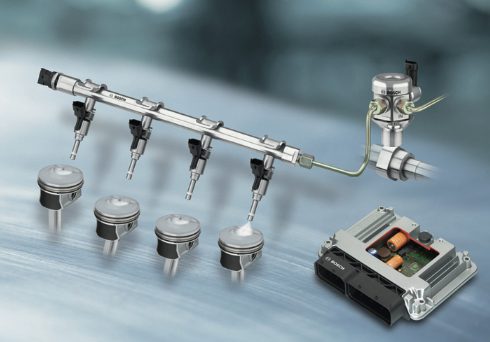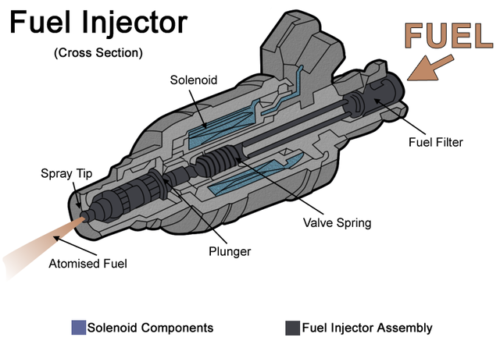Gasoline Direct Injection (GDI) is a fuel delivery system used in modern gasoline engines. Unlike traditional fuel injection systems that spray fuel into the intake manifold, GDI delivers fuel directly into the combustion chamber of the engine. This allows for more precise fuel metering, which improves engine efficiency, power output, and reduces emissions. In this blog post, we’ll take a closer look at the components of gasoline direct injection and how they work together to deliver fuel to the engine.
- High-Pressure Fuel Pump The high-pressure fuel pump is responsible for delivering fuel to the engine at a pressure that is sufficient for direct injection. In a GDI system, the fuel pressure can range from 500 to 2,900 psi, which is much higher than traditional fuel injection systems. The high-pressure fuel pump is typically driven by a camshaft or a separate electric motor and is located in the engine compartment.
- Fuel Rail The fuel rail is a long tube that connects the high-pressure fuel pump to the fuel injectors. It serves as a reservoir for the fuel and maintains a constant pressure to the injectors. The fuel rail is usually made of aluminum or stainless steel and has a high-pressure relief valve that opens if the pressure in the rail exceeds a certain threshold.
- Fuel Injectors The fuel injectors are the most critical component of the GDI system. They are responsible for spraying fuel directly into the combustion chamber of the engine. GDI injectors are typically solenoid-actuated and can be controlled by the engine control unit (ECU). The ECU monitors various engine parameters such as engine speed, throttle position, and load, and adjusts the fuel injection timing and duration accordingly.
- Pressure Sensor The pressure sensor is located in the fuel rail and measures the fuel pressure in real-time. The sensor sends the pressure readings to the ECU, which uses the data to adjust the fuel injection timing and duration. The pressure sensor also provides a safety feature by alerting the ECU if the fuel pressure exceeds a safe level, which can indicate a malfunction in the system.
- Injector Nozzle The injector nozzle is responsible for atomizing the fuel into a fine mist and spraying it into the combustion chamber. The nozzle has a small opening, typically between 0.2 and 0.3 mm in diameter, that controls the fuel flow rate. The nozzle is designed to produce a cone-shaped spray pattern that evenly distributes the fuel in the combustion chamber.
- Electronic Control Unit (ECU) The ECU is the brain of the GDI system. It receives input from various sensors, such as the pressure sensor and the throttle position sensor, and uses this data to adjust the fuel injection timing and duration. The ECU also controls other engine functions such as ignition timing and exhaust gas recirculation. It is responsible for ensuring that the engine operates efficiently and within the specified emissions limits.
In conclusion, GDI is a sophisticated fuel delivery system that relies on several critical components to deliver fuel to the engine. By precisely controlling the fuel metering, GDI systems can improve engine efficiency, power output, and reduce emissions. Understanding the components of GDI is essential for diagnosing and repairing any issues that may arise with the system.

- High-Pressure Fuel Pump: The high-pressure fuel pump is typically a positive displacement pump that uses a piston or diaphragm to pressurize the fuel. It is driven by a camshaft or a separate electric motor that is controlled by the ECU. The high-pressure fuel pump receives fuel from the fuel tank and delivers it to the fuel rail at a pressure that is sufficient for direct injection.
- Fuel Rail: The fuel rail is a long tube that connects the high-pressure fuel pump to the fuel injectors. It has a constant pressure that is maintained by the fuel pressure regulator, which is typically located in the fuel tank. The fuel rail is usually made of aluminum or stainless steel and has a high-pressure relief valve that opens if the pressure in the rail exceeds a certain threshold. This safety feature prevents damage to the fuel system and the engine in case of a malfunction.
- Fuel Injectors: The fuel injectors are solenoid-actuated valves that are controlled by the ECU. They are responsible for spraying fuel directly into the combustion chamber of the engine. The fuel injectors have a small opening, typically between 0.2 and 0.3 mm in diameter, that controls the fuel flow rate. They are designed to atomize the fuel into a fine mist and spray it in a cone-shaped pattern that evenly distributes the fuel in the combustion chamber. GDI injectors are typically more precise than traditional fuel injectors because they can deliver fuel in small, precise quantities at high pressure.
- Pressure Sensor: The pressure sensor is located in the fuel rail and measures the fuel pressure in real-time. It sends the pressure readings to the ECU, which uses the data to adjust the fuel injection timing and duration. The pressure sensor also provides a safety feature by alerting the ECU if the fuel pressure exceeds a safe level, which can indicate a malfunction in the system.
- Injector Nozzle: The injector nozzle is responsible for atomizing the fuel into a fine mist and spraying it into the combustion chamber. The nozzle has a small opening that controls the fuel flow rate and produces a cone-shaped spray pattern that evenly distributes the fuel in the combustion chamber. The nozzle is typically made of a high-strength material, such as ceramic or hardened steel, to withstand the high pressures and temperatures in the combustion chamber.
- Electronic Control Unit (ECU): The ECU is the brain of the GDI system. It receives input from various sensors, such as the pressure sensor and the throttle position sensor, and uses this data to adjust the fuel injection timing and duration. The ECU also controls other engine functions such as ignition timing and exhaust gas recirculation. It is responsible for ensuring that the engine operates efficiently and within the specified emissions limits. The ECU is typically a microcontroller that is programmed with software that controls the various functions of the GDI system.
In summary, GDI is a complex fuel delivery system that uses several components to deliver fuel directly into the combustion chamber of the engine. By precisely controlling the fuel metering, GDI systems can improve engine efficiency, power output, and reduce emissions. The components of GDI work together to ensure that the engine operates efficiently and reliably.
Sure, here are some advantages and disadvantages of gasoline direct injection:
Advantages:
- Improved Fuel Efficiency: GDI systems can improve fuel efficiency by up to 20% compared to traditional fuel injection systems. This is because GDI systems can deliver fuel directly into the combustion chamber, which allows for better control of the fuel-air mixture and more complete combustion.
- Increased Power Output: GDI systems can increase the power output of an engine by up to 10%. This is because GDI systems can deliver more precise amounts of fuel directly into the combustion chamber, which allows for more efficient combustion and improved engine performance.
- Reduced Emissions: GDI systems can reduce emissions of pollutants such as nitrogen oxides (NOx) and particulate matter (PM). This is because GDI systems can precisely control the fuel-air mixture and reduce the amount of unburned fuel that is released into the environment.
- Enhanced Engine Response: GDI systems can provide more precise control over the fuel-air mixture, which can result in better throttle response and improved drivability.
- Lower Maintenance Costs: GDI systems can have lower maintenance costs because they do not require frequent cleaning or replacement of fuel injectors.
Disadvantages:
- Higher Cost: GDI systems can be more expensive than traditional fuel injection systems because they require more sophisticated components such as high-pressure fuel pumps, fuel rails, and pressure sensors.
- Increased Complexity: GDI systems are more complex than traditional fuel injection systems because they require more components and sensors to operate effectively.
- Increased Engine Noise: GDI systems can produce more engine noise than traditional fuel injection systems because they operate at higher pressures and can produce a sharper, more noticeable sound.
- Potential for Carbon Buildup: GDI systems can be more susceptible to carbon buildup on the intake valves and combustion chamber, which can reduce engine performance and increase maintenance costs.
- Higher Maintenance Costs: While GDI systems can have lower maintenance costs in terms of fuel injectors, they can have higher maintenance costs for other components such as high-pressure fuel pumps and fuel rails.
In summary, GDI systems have several advantages such as improved fuel efficiency, increased power output, and reduced emissions. However, they also have some disadvantages such as higher costs, increased complexity, and potential for carbon buildup. Ultimately, the decision to use GDI in an engine will depend on a variety of factors such as cost, performance requirements, and environmental regulations.










